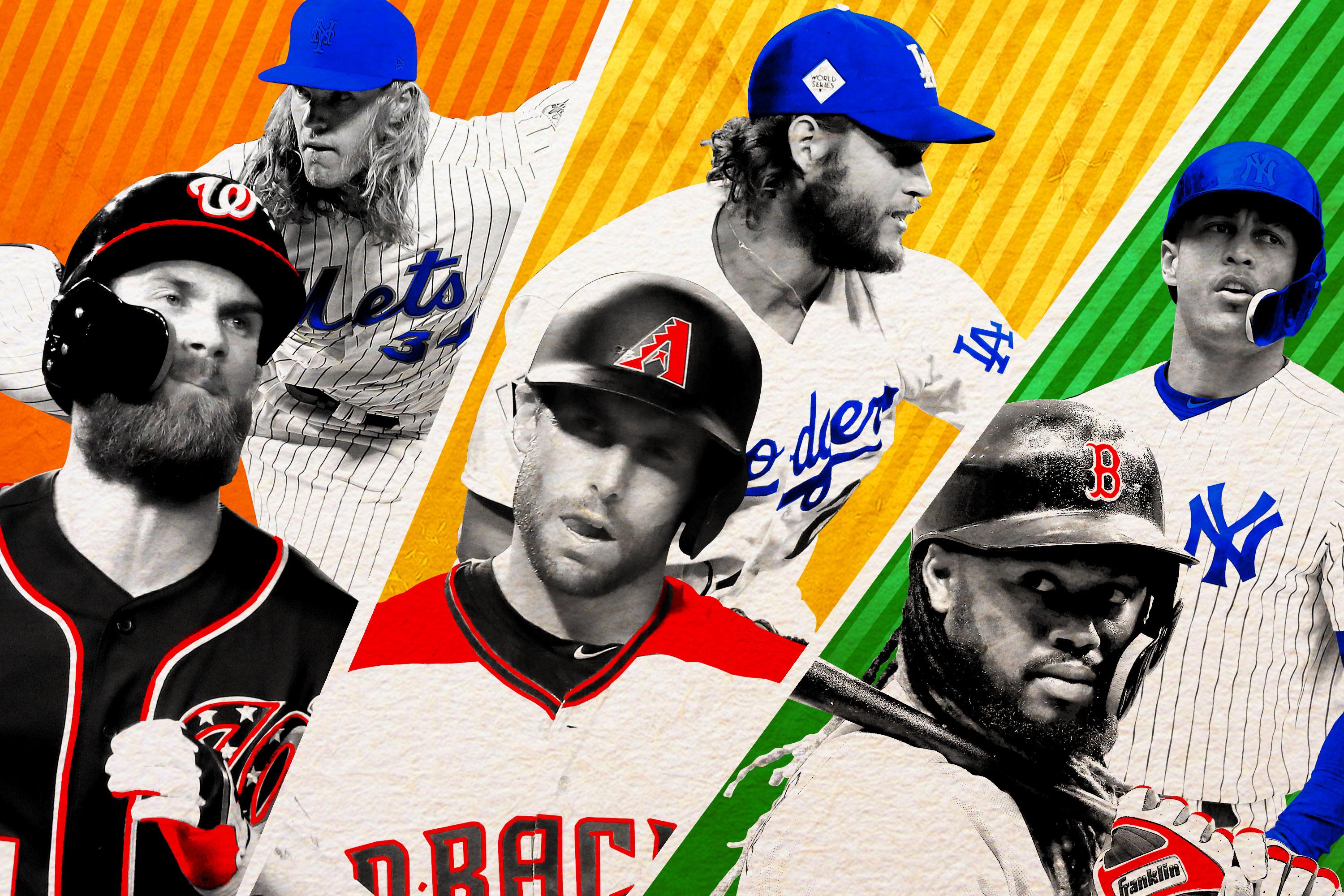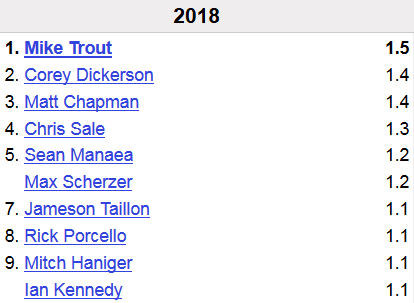
On Monday, Mike Trout climbed atop the Baseball-Reference leaderboard for wins above replacement, the traditional signal for statheads that it’s time to take a new season’s results seriously.

Most of those names probably won’t be there by October—no, Sean Manaea isn’t likely to finish the season sandwiched between Chris Sale and Max Scherzer—but there’s been enough baseball that at least some performances are starting to seem meaningful. And thus far, those performances have yielded nothing but bad news for baseball’s consensus preseason division favorites, all of whom have seen their fortunes fall in the few weeks since Opening Day.
This was supposed to be the season of the superteam. With last year’s postseason qualifiers bringing back a historically high percentage of their positive contributors, and the sport’s unceasing cycle of contending and rebuilding appearing to produce an unusually stratified assortment of teams, conditions seemed ripe for the favorites to win in a walk. Even before the season started, many analysts set their sights on the wild-card races as this season’s sole source of competitive intrigue, all but conceding the division titles to the talent-rich teams at the top of almost every pundit’s projected playoff field. All seven Ringer staffers who participated in our preseason prediction post picked the same six division winners—Astros, Indians, Yankees; Dodgers, Nationals, Cubs—and the projection systems saw the standings the same way. As I wrote at the time, “That’s not so much a vote of confidence in our prognosticative powers as it is a reflection of the reality that [braces for someone to tweet this sentence at me six months from now] the tops of baseball’s divisions look pretty predictable.”
Feel free to start tweeting that sentence at me now. It’s far too soon to say that the sky is falling for any team, Blue Jays and Rogers Centre aside. Big, honking calendar caveats notwithstanding, though, baseball’s big six haven’t yet lived up to their billing. Not one of the consensus preseason favorites is leading its division today, or is even in line for a wild card. Two are in fourth place, and three are in third.
Yes, we’re talking about roughly 15 games played per team—fewer, in some cases, since the early-season snow, wind, and rain that have refused to relent seem particularly prejudiced against the AL Central. Less than 10 percent of the schedule has been settled. But the slow starts by some of the big six, coupled with corresponding hot streaks by a few divisional underdogs, have already given rise to substantial swings in the probable playoff picture.
The table below lists the preseason and current odds of divisional victory for each member of the big six, with each number representing the average of the values displayed on the playoff odds pages at Baseball Prospectus, FanGraphs, and FiveThirtyEight. Each site’s playoff odds account for the current standings and each team’s projected future performance and remaining strength of schedule.
Baseball’s Big, Bad Six
On Opening Day, the six consensus favorites had, on average, a 70.7 percent chance to win their respective divisions. Since then, that figure has sunk to 55.8 percent. The Dodgers, Yankees, Nationals, Astros, and Cubs, in that order, have suffered the five largest declines in divisional-title odds of any teams, with the Indians slotting in at seventh, after the Rays.
A few of these teams aren’t in much more trouble than they were when the season began. The 8-6 Indians have gone from overwhelming favorites to only slightly less overwhelming favorites. And despite nearly being no-hit by Bartolo Colon on Sunday, the 10-7 Astros are playing perfectly fine, with the Angels’ even stronger start—backed up by a major-league-leading plus-48 run differential—largely responsible for the ’Stros’ slight slippage in the standings. The 7-7 Cubs, meanwhile, were always in for a dogfight, although the McCutchen- and Cole-less Pirates, who fell to 11-5 with a loss Monday night, have looked more formidable than anticipated.
However, the three remaining members of the big six have some new reasons to sweat. The Dodgers, Nationals, and Yankees all started the season with significantly greater-than-even odds to win their respective divisions. Together, though, the owners of MLB’s third-, fifth-, and seventh-highest Opening Day payrolls are off to a combined 22-25 start. As a result, their chances of winning division titles have dipped below 50 percent. In the AL East, NL East, and NL West, the playoff odds now favor the field over the likely leader on Opening Day, although the Nationals and Dodgers still have higher odds than any other team in their respective divisions.
This early in the season, movements in team playoff odds have little to do with changing evaluations of team talent; there simply hasn’t been enough action to affect the judgments of algorithms that in most cases consider years of past performance. (Our minds may change more quickly, but that doesn’t mean that they should.) At FanGraphs, for instance, the Dodgers’, Yankees’, and Nationals’ expected rest-of-season winning percentages, unadjusted for schedule—essentially, the site’s best estimates of those teams’ true-talent levels over the rest of 2018—have barely budged since Opening Day. The Dodgers’ expected winning percentage is down just two points; the Yankees’ and Nationals’ are actually up two points. None of those teams has suffered any serious, long-term injury losses since the season started—Justin Turner’s broken wrist, which he sustained in mid-March, was already baked into the Dodgers’ preseason forecast—so as far as the projections are concerned, those teams have essentially the same levels of skill that they seemed to on Opening Day.
The difference, then, stems almost entirely from fluctuations in the standings. The Yankees now trail the Red Sox by five games. The Dodgers, who hoisted themselves into fourth place in the NL West with a win over San Diego on Monday, trail the Diamondbacks by the same margin. And the Nationals, who pulled off a come-from-behind win at Citi Field on Monday night, still trail the Mets by five games as well. In all three cases, the trailing team may be better than the leading team (to say nothing of the other teams in between). But now they have several games to make up, and less than a full season in which to complete comebacks.
Of the three contenders whose odds have fallen the furthest, the Yankees—the only team of the big six that didn’t win its division last season—had the toughest assignment and the smallest margin for error when the season started. New York’s powerful lineup, which was bolstered by a winter trade for reigning NL MVP Giancarlo Stanton, garnered more than its fair share of headlines this spring, but the Red Sox, baseball’s biggest spenders, signed their own slugger in J.D. Martinez, and their hitters have predictably bounced back from a surprisingly subpar 2017 season, matching the Yankees run for run while their pitching staff (which leads the majors in FanGraphs WAR) allows far fewer. The gap between these two teams was always smaller than it was widely perceived to be, and the preseason second fiddle’s MLB-best .867 winning percentage has given Boston a buffer that the Yankees will have a hard time erasing.
The Dodgers’ position isn’t quite as precarious. L.A.’s lineup is littered with weakness that won’t last: Corey Seager, Yasiel Puig, and Joc Pederson have sub-.600 OPS marks, as does the now-sidelined Logan Forsythe, who’s been dealing with shoulder inflammation since spring training. That quartet will be better, and Turner may be weeks away from returning. Kenley Jansen, who caused concern with a cutter that sat sub-90 in his first outing, has seen his velocity rise amid four straight scoreless appearances. And Wilmer Font, who’s allowed 13 runs in 9 1/3 innings and amassed the majors’ third-worst win probability added, has accounted for much of the seasonal sabotage himself. The 11-4 Diamondbacks are the Dodgers’ biggest problem, but that obstacle isn’t insuperable, especially if Arizona starter Taijuan Walker’s forearm inflammation turns out to be more serious than expected.
Like the Dodgers’, the Nationals’ ills are mostly external. Ryan Zimmerman, who may never know the joy of another ultrarelaxed spring training (whether or not that rest in March made him rusty) is hitting .111/.186/.204, which means he’s one Marlin away from being the worst hitter in baseball (minimum 50 painful PA). In only one year has he been a below-average hitter by season’s end, although his health status is uncertain. The injured Adam Eaton may be back by the end of the week, and Daniel Murphy is about to begin playing in extended-spring games. Bryce Harper barely needs bats to hit homers.
The Nationals aren’t worse than we thought they were, but they’re facing more difficult competition than they have in years, the 12-3 Mets foremost among them. The health of the Mets’ pitching staff is one of the young season’s most pleasant surprises. Given that intact rotation, though—and a healthy and hitting Michael Conforto—the team’s success isn’t so surprising. The Mets’ winning percentage was bound to correlate closely with the percentage of team starts made by Noah Syndergaard, Jacob deGrom, Matt Harvey, Steven Matz, and Zack Wheeler. Last year, that rate dropped to 53 percent; this year, it still stands at 100. Only the Astros’ starters have struck out a higher percentage of hitters they’ve faced, and the Mets’ unfamiliar full complement of starting pitchers has helped strengthen the bullpen, too, pushing Seth Lugo and Robert Gsellman at least temporarily into relief roles. The Mets may not have their first- or second-string catchers—Travis d’Arnaud is already done for the year, and Kevin Plawecki’s hand has a hairline fracture—but they won’t fade from the race as long as their pitcher-to-belly-itcher ratio remains high. Even though the ratio can’t go any higher than it has been so far, the Mets have outscored their opponents by a relatively pedestrian 20 runs (fewer than the Braves!), and they’ve outplayed their BaseRuns record—a better reflection of their underlying performance than their wins and losses alone—by four wins, twice as many as the next-most-fortunate team. The majors’ most volatile club is still beatable.
Like so much about baseball in mid-April, the big six’s early stumbles may be forgotten by July, let alone October. We’re only weeks into a journey that lasts for most of the year, and even months into the season, what we thought before the season tells us more about a team than what’s happened in the season so far. Most of the preseason favorites will probably prove the pundits and projections correct. But the concern that this season’s division races appeared to be preordained hasn’t been borne out by any division so far. The odds of upsets are up. Last month I argued that baseball’s elite teams weren’t spoiling the sport’s suspense. But even I may have underestimated how much hope the have-nots had.

